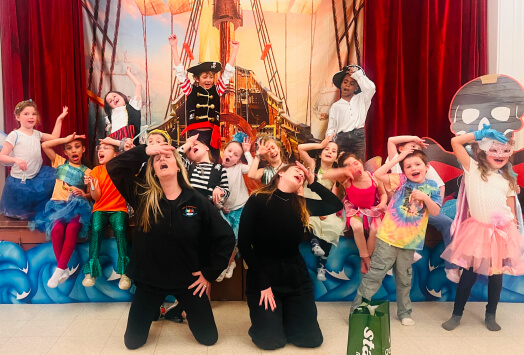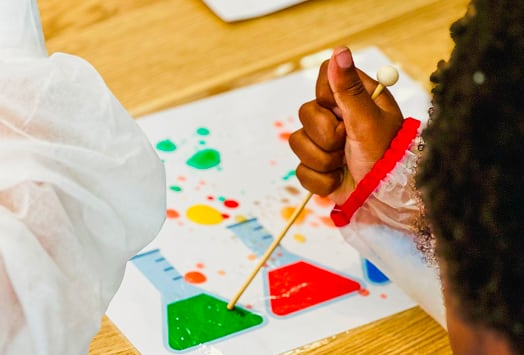Whether you run after school programs, weekend extracurricular activities, summer camps, or some combination of children’s activities, you should consider adding elements of the Montessori method to your curricula and lesson plans.
When you incorporate Montessori techniques, your students and campers get more opportunities to make their own decisions, learn responsibility, be more independent, and grow as people. Sounds pretty good, right? In this guide, we will outline important information about the Montessori method of teaching as well as provide a Montessori lesson plan example and template that you can download.
What is the Montessori Method?
The Montessori method of teaching was created by Dr. Maria Montessori in the early 1900s in Italy. In 1913, the first Montessori school was established in the United States. However, the Montessori Method has become vastly more popular with schools, extracurricular programs, and even camps in the past 30 years.
According to the American Montessori Society (AMS), “Montessori education is student-led and self-paced but guided, assessed, and enriched by knowledgeable and caring teachers, the leadership of their peers, and a nurturing environment.” In short, children who learn with Montessori techniques get the opportunity to explore and follow their curiosities at their own pace. Students in Montessori environments often work on their own and in small groups with a focus on hands-on learning.

There are 5 core components of Montessori education:
- Trained Montessori teachers. Gaining the credentials to properly use the Montessori Method will help students and campers reap the benefits.
- A multi-age classroom or environment. The recommended age range is 3 years between students, which fosters mentorship and leadership within the classroom.
- Montessori materials. Using specially designed Montessori materials will help with hands-on learning.
- Child-directed work. In a Montessori classroom or environment, the students need to have agency to choose what they want to learn and do.
- Uninterrupted work time. One of the hallmarks of Montessori education is long periods of “free choice” time where students can choose what they want to work on without being interrupted or prompted to move on.
You can learn more about the core components of Montessori education on the AMS website.
Benefits of Montessori education
There are many benefits of Montessori education for children of all ages. Having this knowledge will help you, as an educator, when speaking with parents and families about why Montessori techniques are important to your classes and activities.
According to a 2021 study published in Frontiers of Psychology, learning with the Montessori Method positively correlates to increased adult wellbeing. That is because Montessori education prepares children to become self-reliant and empathetic adults. Here are some of the other benefits of Montessori education.
- Students learn at their own pace, so they don’t fall behind. They also learn to advocate for themselves from an early age.
- Children gain the ability to educate themselves and think critically about what they are learning, increasing their self-regulation.
- Students gain access to a caring community where younger students have mentors and older students can become leaders.
- Children become more independent and active in making decisions about their lives.
- Using intrinsic motivation and internal satisfaction, students seek answers to questions that interest them and utilize tools to gain knowledge in a positive light.
- Students become adept at looking at their own work critically, so that they can find, correct, and learn from errors.
- Children gain stronger social-emotional skills than children in traditional learning environments, according to the AMS.

Montessori lesson plans
Even though Montessori education is all about self-directed learning, creating lesson plans and a curriculum is still important. Writing a lesson plan helps keep educators on track while teaching and ensures that the students have enough time to learn everything they need to know.
In her book, The Montessori Method, Maria Montessori outlines the 3 most important elements of Montessori lesson plans: conciseness, simplicity, and objectiveness. Educators should not speak for the sake of speaking, instead they should focus on teaching only what is necessary so it is easy for the student to understand. Finally, the educator should not be placed at the center of the lesson: their personality and opinions should not come through when teaching.
Montessori lessons are split up using the Three Period Lesson plan, but with an added step at the beginning.
Three Period Lesson
- The Montessori beginning. Before you can teach something new to your students, they need to be able to understand the concepts. For example, if you are planning to teach your students about animals, they need to be able to differentiate between types of animals, even if they do not know the names of them yet. Therefore, before you begin the lesson, you can show them pictures of animals and ask them to sort or match them.
- First Period. The educator presents the item that they want the child to learn in the lesson. In the animal example, it can be a dog. They say, “this is a dog” and show a picture of a dog. They can also show 2-3 other animal photos as comparisons so the children can see what a dog isn’t.
- Second Period. Now, the educator asks the child to show them where the dog is in a group of photos of animals. If the child gets the answer incorrect, Montessori says the educator should not let them know. Instead, they should end the lesson and return to it another time when the child can get it right.
- Third Period. In this period, the child should be able to label the dog on their own. If they cannot, the teacher and child should return to the first and second periods until they can.
Remember: Montessori lessons are typically taught 1-on-1 or in small groups with a focus on hands-on activities. Therefore, when preparing your Montessori lesson plans, it is important for you to think of the lesson as a conversation.

Montessori lesson plan format
1. Lesson objective
When you start writing a lesson plan, it is important to decide the goal of the lesson. What are children going to learn or be able to do at the end of the class? This section should be action-oriented and measurable.
Lesson objective examples
- Organize animals by size.
- Create a ceramic art piece that is ready for the kiln.
- Master a 6 sentence back-and-forth French dialogue.
2. Skills practiced
Montessori education is all about helping children gain the skills they need to be successful. Therefore, educators writing Montessori lesson plans should make sure to track the skills that their students will be practicing while accomplishing the learning objective.
For example:
- For the objective of organizing animals by size, the skills practiced could be fine and gross motor skills, shape recognition, sorting, pencil grip, and more, depending on the materials needed for the lesson.
- For the objective of creating a ceramic art piece, the skills practiced could be fine and gross motor skills, shaping, forward-thinking, emotional regulation, cleaning up, and more.
- Finally, for the objective of mastering a French dialogue, the skills practiced could be collaboration, French vocabulary, syntax, empathy, and more.
3. Assessment
How will you measure the success of the lesson? Make sure this section remains child-led. Can they show you how they have mastered the objective?
4. Prerequisite knowledge
This section is just for you to make sure that your students are ready for this lesson. What background do they need to have before they can participate and succeed in this lesson?
5. Lesson delivery
How will you actually give this lesson to your students? What will you say and do to ensure that they accomplish the objective set at the beginning of your lesson plan? In this section, include the activities that you will do with your students as well as the information that you need to pass along in the first and second periods.
6. Questions or stumbling blocks
What will you do if the student is unable to complete the activity or task? What questions are you anticipating that they might ask? Use this section to plan for those situations so that you are prepared.
7. Materials required
What do you need to do this lesson and the associated activities? Create a list in this section and then remember to bring everything that you need! Not sure where to buy supplies? Check out our guide.
8. Future activities
What is next for you and your students related to this topic? Can you come up with some independent, but related, activities that can be added to the classroom or learning environment so the children can explore on their own when the lesson is over? For example, in the animal sorting lesson, maybe you can add some extra photos or stuffed animals around the room for the students to sort or play with later.
Get your editable Montessori lesson plan template
Including Montessori techniques into your activities and camps is a great way to help the students and campers grow into independent and responsible adults. If you are looking for guidance on managing and running your children’s education and activity business, the team at Sawyer is here to help.
With our suite of tools, like custom forms to record allergies and t-shirt sizes, flexible payment options like gift cards and installment plans, and seamless scheduling and registration on any device, Sawyer saves business owners 28 hours per month. If you are ready to spend less time on admin and more time doing what you love, see how Sawyer can help with a free trial or demo.





















.png)












.avif)
.avif)
.avif)
.avif)




